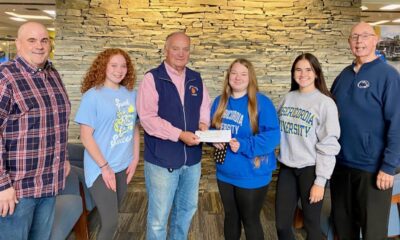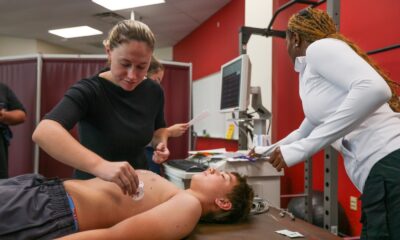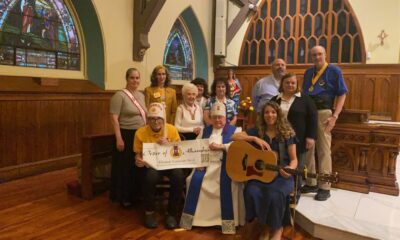Lifestyle
Mayors Celebrate 120 Years of Wireless Communication Legacy

A unique celebration took place on Saturday as the mayors of Wilkes-Barre and Scranton recreated the world’s first successful wireless telegraph conversation, marking the 120th anniversary of this groundbreaking event. Using technology developed by the Rev. Jozef Murgas, a priest from Sacred Heart Church in Wilkes-Barre, the mayors communicated wirelessly over a distance of 20 miles, just as it was done on November 23, 1905.
Wilkes-Barre Mayor George Brown initiated the transmission from King’s College, while Scranton Mayor Paige Gebhardt Cognetti responded from the University of Scranton. Brown recited a message originally sent by Wilkes-Barre Mayor Fred Kirkendall to Scranton Mayor Alex Connell in 1905: “Wilkes-Barre and Father Murgas send their best wishes to you and to our healthy daughter, Miss Scranton.” The message was transmitted using Morse code, a series of buzzes and beeps representing dots and dashes.
Cognetti then delivered Connell’s reply, expressing gratitude to Murgas: “Scranton sends hearty congratulations to Father Murgas, our mother city’s foremost inventor. May he live long enough to derive all the benefits he is entitled to.”
The event took place outside the Father Joseph Murgas Room in the Richard Abbas Alley Center for Health Sciences, located a few blocks from the site of Murgas’ original work in wireless communication. His contributions, though overshadowed by those of Italian inventor Guglielmo Marconi, are recognized by many as pivotal in the development of modern radio technology.
Murgas demonstrated the feasibility of wireless transmission over land, a claim Marconi had contested, insisting it could only succeed over water. Historical accounts indicate that during one of Marconi’s visits to the United States, he received encouragement from Thomas Edison to pay attention to Murgas’ innovations.
During a visit to Wilkes-Barre in August 1905, President Theodore Roosevelt discreetly toured Murgas’ laboratory, further underscoring the significance of his work. After years of experimentation in the basement of the church and securing patents, Murgas, alongside investors, constructed two 200-foot antenna towers in both Wilkes-Barre and Scranton.
Despite the success of the first transmission, the towers suffered severe damage from a storm, and some investors passed away, leading Murgas to abandon his wireless telegraphy experiments. Faced with Marconi’s superior financial resources and government contracts, Murgas shifted his focus back to parish duties. Known as the “radio priest,” he was also an accomplished painter, architect, botanist, and naturalist, holding a patent for an early fly-fishing reel and amassing a butterfly collection considered the largest in North America.
The gathering was organized in collaboration with the Murgas Amateur Radio Club and the Slovak Heritage Society of Northeastern Pennsylvania. Born in Slovakia in 1864, Murgas was ordained in 1888 and immigrated to the United States to aid in completing the Sacred Heart Church in Wilkes-Barre, a hub for the Slovak community. Murgas passed away in May 1929 and is interred in Sacred Heart Cemetery, which he established during his tenure as a parish leader.
This historical event not only commemorates Murgas’ innovative spirit but also highlights the enduring legacy of wireless communication that continues to shape the world today.
-

 Technology5 months ago
Technology5 months agoDiscover the Top 10 Calorie Counting Apps of 2025
-

 Health3 months ago
Health3 months agoBella Hadid Shares Health Update After Treatment for Lyme Disease
-

 Health3 months ago
Health3 months agoErin Bates Shares Recovery Update Following Sepsis Complications
-

 Technology4 months ago
Technology4 months agoDiscover How to Reverse Image Search Using ChatGPT Effortlessly
-

 Technology1 month ago
Technology1 month agoDiscover 2025’s Top GPUs for Exceptional 4K Gaming Performance
-

 Technology3 months ago
Technology3 months agoElectric Moto Influencer Surronster Arrested in Tijuana
-

 Technology5 months ago
Technology5 months agoMeta Initiates $60B AI Data Center Expansion, Starting in Ohio
-

 Technology5 months ago
Technology5 months agoRecovering a Suspended TikTok Account: A Step-by-Step Guide
-

 Health4 months ago
Health4 months agoTested: Rab Firewall Mountain Jacket Survives Harsh Conditions
-

 Lifestyle5 months ago
Lifestyle5 months agoBelton Family Reunites After Daughter Survives Hill Country Floods
-

 Health3 months ago
Health3 months agoAnalysts Project Stronger Growth for Apple’s iPhone 17 Lineup
-

 Technology4 months ago
Technology4 months agoHarmonic Launches AI Chatbot App to Transform Mathematical Reasoning





















